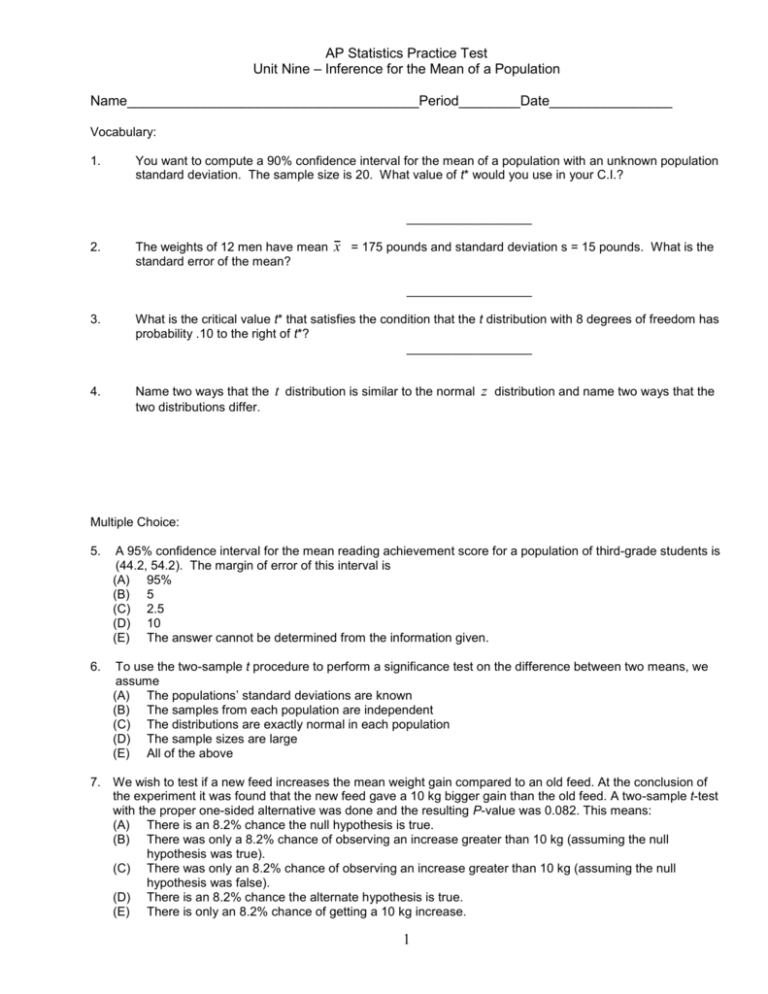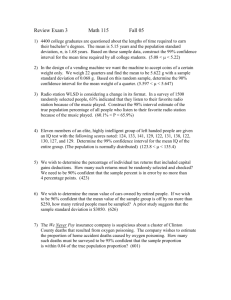AP Statistics Practice Test
advertisement

AP Statistics Practice Test Unit Nine – Inference for the Mean of a Population Name______________________________________Period________Date________________ Vocabulary: 1. You want to compute a 90% confidence interval for the mean of a population with an unknown population standard deviation. The sample size is 20. What value of t* would you use in your C.I.? __________________ 2. The weights of 12 men have mean x = 175 pounds and standard deviation s = 15 pounds. What is the standard error of the mean? __________________ 3. What is the critical value t* that satisfies the condition that the t distribution with 8 degrees of freedom has probability .10 to the right of t*? __________________ 4. Name two ways that the two distributions differ. t distribution is similar to the normal z distribution and name two ways that the Multiple Choice: 5. A 95% confidence interval for the mean reading achievement score for a population of third-grade students is (44.2, 54.2). The margin of error of this interval is (A) 95% (B) 5 (C) 2.5 (D) 10 (E) The answer cannot be determined from the information given. 6. To use the two-sample t procedure to perform a significance test on the difference between two means, we assume (A) The populations’ standard deviations are known (B) The samples from each population are independent (C) The distributions are exactly normal in each population (D) The sample sizes are large (E) All of the above 7. We wish to test if a new feed increases the mean weight gain compared to an old feed. At the conclusion of the experiment it was found that the new feed gave a 10 kg bigger gain than the old feed. A two-sample t-test with the proper one-sided alternative was done and the resulting P-value was 0.082. This means: (A) There is an 8.2% chance the null hypothesis is true. (B) There was only a 8.2% chance of observing an increase greater than 10 kg (assuming the null hypothesis was true). (C) There was only an 8.2% chance of observing an increase greater than 10 kg (assuming the null hypothesis was false). (D) There is an 8.2% chance the alternate hypothesis is true. (E) There is only an 8.2% chance of getting a 10 kg increase. 1 8. Which of the following is an example of a matched pairs design? (A) A teacher compares the pretest and posttest scores of students. (B) A teacher compares the scores of students using a computer based method of instruction with the scores of other students using a traditional method of instruction. (C) A teacher compares the scores of students in her class on a standardized test with the national average score. (D) A teacher calculates the average of scores of students on a pair of tests and wishes to see if this average is larger than 80%. (E) None of these. 9. When performing a test of significance about a population mean, a t-distribution, instead of a normal distribution, is often utilized. Which of the following is the most appropriate explanation for this? (A) (B) (C) (D) (E) The sample size is not large enough to assume that the population distribution is normal. The sample does not follow a normal distribution. There is an increase in the variability of the test statistic due to estimation of the population standard deviation. The sample standard deviation is unknown. The population standard deviation is too large. Free Response: National Fuelsaver Corporation manufactures the Platinum Gasaver, a device they claim “may increase gas mileage by 22%.” Here are the percent changes in gas mileage for 15 identical vehicles, as presented in one of the company's advertisements: 48.3 28.7 46.9 28.7 46.8 24.8 44.6 10.8 40.2 10.4 38.5 6.9 34.6 33.7 -12.4 10. Describe the population of interest and the parameter you want to draw conclusions about. 11. Graph the data (sketch below) and comment on skewness and outliers. Can the t procedures be used in this situation? 12. What is the critical value t for a 90% confidence interval? ________________ 13. Construct a 90% confidence interval, regardless of your answer in question 11. 14. Interpret this confidence interval. Then, comment on the manufacturer’s claim based on your C.I. 2 15. A study reported the results of an experiment in which seven pairs of children reading below grade level were obtained by matching, so that within each pair the two children were equally deficient in reading ability. Then one child from each pair received experimental training, while the other received standard training. Based on the accompanying improvement scores, does the experimental training appear to be superior to the standard training? Use a 0.1 significance level. ALL STEPS!! PAIR Experimental Standard (control group) 1 3 3 4 5 6 7 0.5 0.8 1.0 1.1 0.6 -0.1 0.1 0.2 1.3 0.2 0.1 1.5 1.0 0.8 16. An educational group claims that teaching fraction concepts using math manipulatives results in higher student achievement and understanding of fractions than teaching fractions without the use of any math manipulatives. A teacher in a middle school taught a unit on fractions to two sixth grade classes, one using math manipulatives and the other without the use of any manipulatives. The table below shows the performance of these two classes on a unit test on fractions. With Manipulatives Without Manipulatives 85 78 75 84 83 81 87 78 80 76 79 83 88 79 94 75 87 85 82 81 Test the claim that students who use manipulatives show higher achievement on a test of fractions. Use a significance level of 0.05. 3 17. In some mining operations, a byproduct of the processing is mildly radioactive. Of prime concern is the possibility that release of these byproducts into the environment may contaminate the freshwater supply. There are strict regulations for the maximum allowable radioactivity in supplies of drinking water, namely an average of 5 picocuries per liter (pCi/L) or less. However, it is well known that even safe water has occasional hot spots that eventually get diluted, so samples of water are assumed safe unless there is evidence to the contrary. A random sample of 25 specimens of water from a city’s water supply gave a mean of 5.35 pCi/L and a standard deviation of 0.84 pCi/L. Carry out an appropriate test and set the significance level at 0.05. Popular wisdom is that eating presweetened cereal tends to increase the number of dental cavities in children. A sample of children was entered into a study and followed for several years. Each child was classified as a sweetened-cereal lover or a nonsweetened-cereal lover. At the end of the study, the amount of tooth damage was measured. Here is the data: Group Sugar lovers No sugar n 10 15 mean 6.41 5.20 std. dev 5.0 15.0 The t* critical value needed to find a 95% confidence interval for the difference in the mean tooth damage is: ___________________ 18. Using the data from above, construct a 90% confidence interval for the difference in the mean tooth damage. Do all steps. Review: 19. Which measure is more sensitive to outliers, mean or median? ________________________ 20. True or false. The amount of people who pass this exam is discrete. _________________ 4 21. True or False. A z score tells how many standard deviations a value is from the mean. ____________ 22. We say that the design of a study is biased if which of the following is true? (A) A racial or sexual preference is suspected (B) Random placebos have been used (C) Certain outcomes are systematically favored (D) The correlation is greater than 1 or less than –1 22. Control groups are used in experiments in order to . . . (A) Control the subjects of a study so as to insure all participate equally (B) Control the effects of lurking variables such as the placebo effect (C) Guarantee that someone other than the investigators, who have a vested interest in the outcome, control how the experiment is conducted (D) Achieve a proper and uniform level of randomization 23. Assume that the following is a binomial distribution. Seventy percent of all trucks undergoing a brake inspection at a certain inspection facility pass the inspection. Consider groups each consisting of 15 trucks. Find the probability of having exactly 10 trucks pass the inspection. ___________________ 24. There are no daytime speed limits for automobiles on sections of the state highways and freeways in the state of Montana. Let x = the speed of an automobile on a Montana highway. Suppose that the mean speed of an automobile on a Montana highway is 72 miles per hour and the standard deviation is 4 miles per hour. We will randomly select 100 automobiles traveling the road in Montana. a. Determine the mean and the standard deviation of the sampling distribution. b. What is the probability that the sample mean is at most 72.5? ______________________ 5








